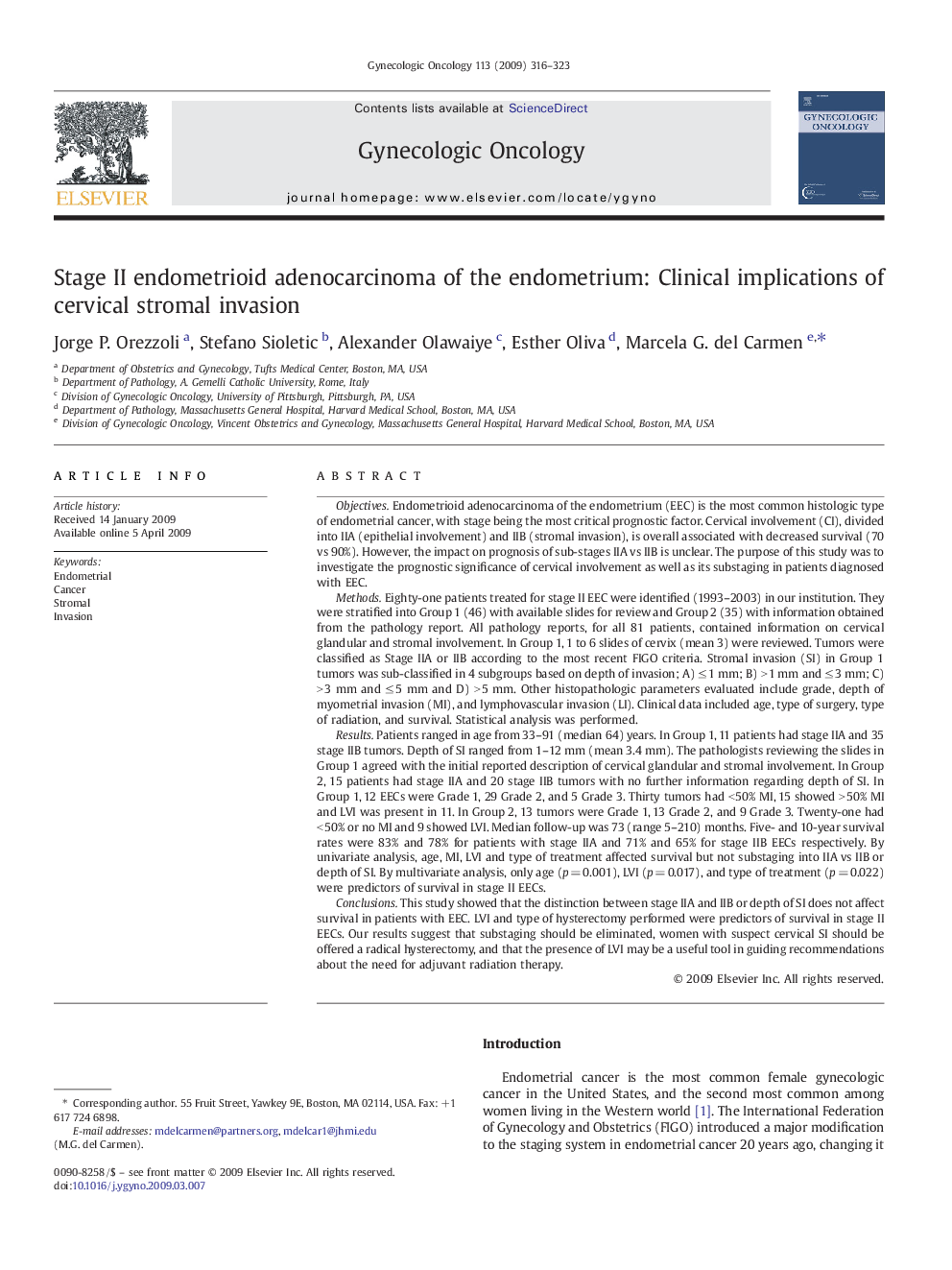| کد مقاله | کد نشریه | سال انتشار | مقاله انگلیسی | نسخه تمام متن |
|---|---|---|---|---|
| 3945883 | 1254303 | 2009 | 8 صفحه PDF | دانلود رایگان |

ObjectivesEndometrioid adenocarcinoma of the endometrium (EEC) is the most common histologic type of endometrial cancer, with stage being the most critical prognostic factor. Cervical involvement (CI), divided into IIA (epithelial involvement) and IIB (stromal invasion), is overall associated with decreased survival (70 vs 90%). However, the impact on prognosis of sub-stages IIA vs IIB is unclear. The purpose of this study was to investigate the prognostic significance of cervical involvement as well as its substaging in patients diagnosed with EEC.MethodsEighty-one patients treated for stage II EEC were identified (1993–2003) in our institution. They were stratified into Group 1 (46) with available slides for review and Group 2 (35) with information obtained from the pathology report. All pathology reports, for all 81 patients, contained information on cervical glandular and stromal involvement. In Group 1, 1 to 6 slides of cervix (mean 3) were reviewed. Tumors were classified as Stage IIA or IIB according to the most recent FIGO criteria. Stromal invasion (SI) in Group 1 tumors was sub-classified in 4 subgroups based on depth of invasion; A) ≤ 1 mm; B) > 1 mm and ≤ 3 mm; C) > 3 mm and ≤ 5 mm and D) > 5 mm. Other histopathologic parameters evaluated include grade, depth of myometrial invasion (MI), and lymphovascular invasion (LI). Clinical data included age, type of surgery, type of radiation, and survival. Statistical analysis was performed.ResultsPatients ranged in age from 33–91 (median 64) years. In Group 1, 11 patients had stage IIA and 35 stage IIB tumors. Depth of SI ranged from 1–12 mm (mean 3.4 mm). The pathologists reviewing the slides in Group 1 agreed with the initial reported description of cervical glandular and stromal involvement. In Group 2, 15 patients had stage IIA and 20 stage IIB tumors with no further information regarding depth of SI. In Group 1, 12 EECs were Grade 1, 29 Grade 2, and 5 Grade 3. Thirty tumors had < 50% MI, 15 showed > 50% MI and LVI was present in 11. In Group 2, 13 tumors were Grade 1, 13 Grade 2, and 9 Grade 3. Twenty-one had < 50% or no MI and 9 showed LVI. Median follow-up was 73 (range 5–210) months. Five- and 10-year survival rates were 83% and 78% for patients with stage IIA and 71% and 65% for stage IIB EECs respectively. By univariate analysis, age, MI, LVI and type of treatment affected survival but not substaging into IIA vs IIB or depth of SI. By multivariate analysis, only age (p = 0.001), LVI (p = 0.017), and type of treatment (p = 0.022) were predictors of survival in stage II EECs.ConclusionsThis study showed that the distinction between stage IIA and IIB or depth of SI does not affect survival in patients with EEC. LVI and type of hysterectomy performed were predictors of survival in stage II EECs. Our results suggest that substaging should be eliminated, women with suspect cervical SI should be offered a radical hysterectomy, and that the presence of LVI may be a useful tool in guiding recommendations about the need for adjuvant radiation therapy.
Journal: Gynecologic Oncology - Volume 113, Issue 3, June 2009, Pages 316–323